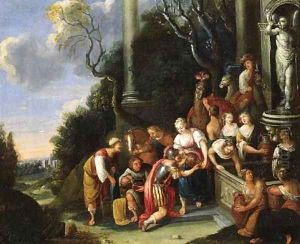Maximilian Herregouts Paintings
Maximilian Herregouts was a Flemish painter born in 1634 in Antwerp, a city renowned for its vibrant art scene during the 17th century. Despite being less well-known than some of his contemporaries, Herregouts made a significant contribution to the Baroque movement, which was characterized by dramatic expression, rich coloration, and bold manipulation of light and shadow. His work often delved into religious and mythological themes, reflecting the era's interest in these subjects as means of exploring human emotion and divine presence.
Not much is known about Herregouts' early life or training. It is believed he was born into a family with artistic ties, which was common in Antwerp, a city that was home to Peter Paul Rubens and Anthony van Dyck. Herregouts' style suggests that he was influenced by the great masters of his time, possibly having studied their works or even apprenticed under a notable artist. However, specific details about his education in the arts remain speculative.
Herregouts' career is marked by his move from Antwerp to Bruges, then a significant artistic center, where he became a master in the Guild of St. Luke in 1661. This move was pivotal for Herregouts, as it opened up new opportunities for commissions in a city that was slightly more conservative than Antwerp but still appreciated the evolving tastes of the Baroque period. His works from this period include altarpieces for local churches and private commissions that showcase his ability to blend spiritual themes with the dynamic, expressive style of the Baroque.
Despite his contributions to the art of his time, Maximilian Herregouts did not achieve the lasting fame of his peers. Records indicate that he was active until at least 1680, but the exact date of his death remains uncertain. Today, his works are studied by those interested in the depth and diversity of Flemish painting, offering insights into the lesser-known artists who played roles in the development of Baroque art. His paintings, while not as prolifically preserved as those of his more famous counterparts, provide a window into the religious and cultural narratives of 17th-century Flanders.
